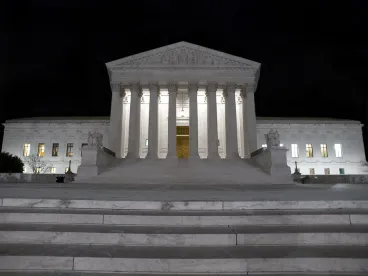The U.S. Supreme Court ruled today that the pendency of a securities class action does not allow individual class members to opt out of the class and file separate actions under the Securities Act of 1933 more than three years after the relevant securities offering took place. The Court's decision in California Public Employees' Retirement System v. ANZ Securities, Inc. (No. 16-373) – which likely applies as well to securities-fraud suits under the Securities Exchange Act of 1934 – establishes that statutes of repose such as the three-year statute in the Securities Act (and the five-year statute in the Exchange Act) are designed to limit defendants' liability and cannot be tolled based on equitable considerations.
The ANZ decision should provide additional certainty to defendants about their scope of potential liability when they settle securities class actions. The ruling should ensure that defendants will not be subject to individual opt-out actions filed after the repose date – and that the class-action settlement and any other suits filed before the repose date will limit the scope of defendants' exposure.
Background
The ANZ case addresses the interplay between the "American Pipe" class-action tolling doctrine and the statutory time periods for suits under the Securities Act (and, by implication, the Exchange Act).
In American Pipe & Construction Co. v. Utah, 414 U.S. 538 (1974), and Crown, Cork & Seal Co. v. Parker, 462 U.S. 345 (1983), the Supreme Court held that the commencement of a class action suspends the statute of limitations for all putative class members who would have been parties had the case continued as a class action. American Pipe and its progeny generally allow putative class members to intervene in a class action or to file their own independent actions after the limitations period has expired. This class-action tolling rule avoids the prospect that putative class members would feel compelled to file individual, duplicative lawsuits to protect their own rights in case of a denial of class certification after the expiration of the limitations period.
Section 13 of the Securities Act prescribes two time periods for bringing actions under § 11 or § 12 of the statute. The first part says: "No action shall be maintained to enforce any liability created under Section 11 or Section 12(a)(2) unless brought within one year after the discovery of the untrue statement or the omission, or after such discovery should have been made by the exercise of reasonable diligence . . . ." The second part states: "In no event shall any such action be brought to enforce a liability created under Section 11 . . . more than three years after the security was bona fide offered to the public, or under Section 12(a)(2) more than three years after the sale." 15 U.S.C. § 78m (bold italics added).
The statute governing suits under the Exchange Act contains a similar two-part structure: "A private right of action that involves a claim of fraud, deceit, manipulation, or contrivance in contravention of a regulatory requirement concerning the securities laws . . . may be brought not later than the earlier of (1) 2 years after the discovery of the facts constituting the violation; or (2) 5 years after such violation." 28 U.S.C. § 1658(b) (emphasis added).
Previous decisions had construed the Securities Act's and the Exchange Act's discovery-rule prongs as statutes of limitations, which could be tolled based on equitable or jurisprudential considerations, including American Pipe tolling principles. But courts had held the statutes' second prong (the three-year and five-year periods under the Securities Act and the Exchange Act, respectively) to be statutes of repose – absolute, nontollable bars to further actions.
The ANZ case raised the question whether American Pipe class-action tolling principles could apply to the repose prong of § 13 of the Securities Act. The plaintiff had been a member of the putative class in a timely filed class action, but it had opted out of the class and filed its own action more than three years after the securities had been offered to the public. The plaintiff sought to rely on the underlying class action as the "action" that had been brought within the allowable three-year period. The District Court rejected the argument, holding that American Pipe principles could not toll statutes of repose. The Second Circuit affirmed, as did the Supreme Court.
Supreme Court's Decision
The Court (through Justice Kennedy) first confirmed statements in prior decisions that § 13's three-year prong is a statute of repose, not a statute of limitations. The Court ruled that "[t]he 3-year time bar in § 13 reflects the legislative objective to give a defendant a complete defense to any suit after a certain period."
The Court next held that, because § 13 is a statute of repose, rather than a statute of limitations, it cannot be overridden by equitable considerations such as those animating the American Pipe tolling doctrine. "By establishing a fixed limit, a statute of repose implements a legislative decisio[n] that as a matter of policy there should be a specific time beyond which a defendant should no longer be subjected to protracted liability." Judicially created tolling doctrines derived from equity principles, such as the American Pipe rule, "cannot alter the unconditional language and purpose of the 3-year statute of repose."
The Court rejected plaintiff's argument (which the dissenting Justices embraced) that the filing of a class action fulfills the purposes of a statutory time limit for later-filed suits because the class action "puts a defendant on notice as to the content of the claims against it and the set of potential plaintiffs who might assert those claims." The Court ruled that, while "generic notice satisfied the purposes of the statute of limitations" in American Pipe, it does not do so for a statute of repose "because the purpose of a statute of repose is to give the defendant full protection after a certain time." The Court added that, "[i]f the number and identity of individual suits, where they may be filed, and the litigation strategies they will use are unknown, a defendant cannot calculate its potential liability or set its own plans for litigation with much precision. The initiation of separate individual suits may thus increase a defendant's practical burden."
The Court also rejected plaintiff's statutory argument that the individual case was timely filed because the timely class action was the "action" that must be "brought" within three years under § 13. The majority held that "[t]he term 'action' . . . refers to a judicial 'proceeding,' or perhaps to a 'suit' – not to the general content of claims" such as those asserted in the later individual case. "[I]t defies ordinary understanding to suggest that [the individual plaintiff's] filing – in a separate forum, on a separate date, by a separate named party – was the same 'action,' 'proceeding,' or 'suit'" as the earlier class action.
Implications
The ANZ decision should resolve the question whether statutes of repose – as opposed to statutes of limitations – can be tolled based on equitable principles such as the American Pipe tolling rule. The Court made clear that tolling of statutes of repose "is permissible only where there is a particular indication that the legislature did not intend the statute to provide complete repose but instead anticipated the extension of the statutory period under certain circumstances." The Court saw no such indication in § 13.
ANZ's rationale will likely apply to the five-year statute of repose in the Exchange Act. The Exchange Act's structure is similar to the Securities Act's: a shorter "discovery" period and a longer "repose" period. The Court noted that "[t]he pairing of a shorter statute of limitations and a longer statute of repose is a common feature of statutory time limits" and confirms that the statute of repose was intended to create an absolute limit on the defendant's liability.
This nontollable bar on future suits should help assure defendants who settle a class action that they will not be exposed to opt-out litigation filed outside the statute of repose. Whether the nontollable bar will motivate individual class members to file "protective" individual actions within the repose period remains to be seen – although, as the Court noted, empirical evidence to date does not suggest that a deluge of such cases will be filed.
The four dissenting Justices (Justice Ginsburg, with Justices Breyer, Sotomayor, and Kagan) issued words of caution to courts and class counsel handling class actions. The dissent expressed concern that "[d]efendants will have an incentive to slow walk discovery and other precertification proceedings so the clock will run on potential opt outs." Accordingly, the dissenters suggested that, "[a]s the repose period nears expiration, it should be incumbent on class counsel, guided by district courts, to notify class members about the consequences of failing to file a timely protective claim." Quoting from an amicus brief filed by a group of retired federal judges, the four Justices added that, "'[a]t a minimum, when notice goes out to a class beyond [§ 13's limitations period], a district court will need to assess whether the notice [should] alert class members that opting out . . . would end [their] chance for recovery.'" These issues might therefore arise in future class-action proceedings.





 />i
/>i

